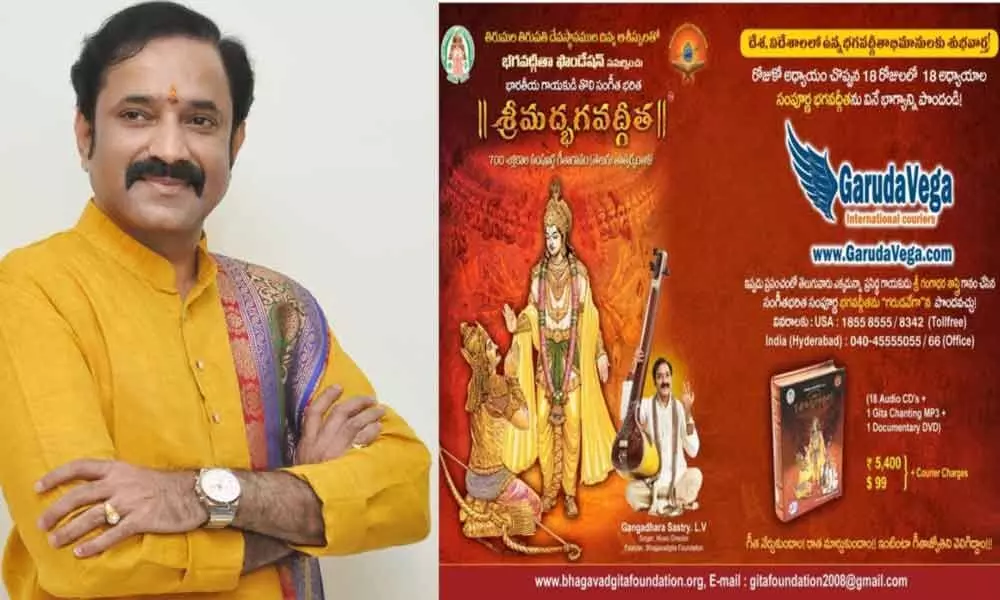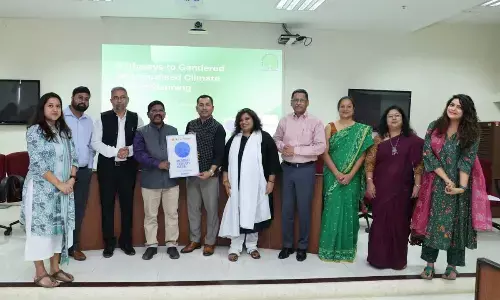Bhagavad Gita- the universal text

When doubts haunt me, when disappointment stares me in the face and when I see not one ray of light on the horizon, I turn to the Bhagavad Gita and find a verse to comfort me and I immediately begin to smile in the midst of overwhelming sorrow.
When doubts haunt me, when disappointment stares me in the face and when I see not one ray of light on the horizon, I turn to the Bhagavad Gita and find a verse to comfort me and I immediately begin to smile in the midst of overwhelming sorrow. My life has been full of external tragedies and if they had not left any visible scars and indelible effect on me, I owe it to the teachings of Bhagavad Gita" Mahatma Gandhi's words stemmed from his life's experience.
The battlefield of Mahabharata where the great text was revealed by the' Jagadguru' (universal guru) Krishna to disciple /relative Arjuna who could not muster the courage to fight his own people was seen by Gandhi as an allegory representing the battle between good and evil going on within every individual. Ironically Gandhi's own introduction to the Gita was in England and through two English brothers who gave him the English version of the Gita by Sir Edwin Arnold. The book got him captivated for life and he took to reading it every single day in the original Sanskrit language in later years.
The fount of wisdom, the text which is 5,120 years old is truly the sacred song with deep philosophy, spirituality and divinity embodied in it, inspiring people like Thoreau, Aldous Huxley, Einstein, Oppenheimer and Emerson among others. The three great Acharayas of India Shankara, Ramanuja and Madhava interpreted the Gita to advocate their stand of monism, qualified dualism and dualism respectively. In modern times Lokamanya Tilak opined that action (karmayoga) was the real message while Gandhi believed that action without expectation of fruit (anasaktiyoga) was the quintessence of this great work that defines the "Way of life".
Shankaracharya in particular says at the beginning of his commentary that Bhagavad Gita is the epitomised essence of all Vedic Knowledge and this is the reason why scholars all over the world are drawn to it. The fundamental philosophy of the Gita is applicable to all climes and times, all countries, religions and creeds." It is a narrow view to think of Gita as a religious text. It is the deepest and the most secret wisdom applicable to all mankind" says Swami VidyaPrakashananda in his book titled "Gita Makaranda" (the nectar of Gita). So how does the study of Bhagavad Gita provide answers to all problems that human beings are confronted with?
"Show me any inspiring quotation from any source and I will show you how it is originates from the BhagavadGita. It is a book of do's and don'ts- a practical guide to lead a life rooted in dharma, the best book on personality development and a practicing text that has to be applied in every life situation'' says L.V. Gangadhar Sastry, eminent playback singer, music director and Founder –President of the BhagavadGita Foundation committed to spreading the knowledge of Gita as a dynamic life enhancing guide. Stating that this text is not for those opting for retirement as is commonly perceived, he says it is most relevant to youth and has to be taught from the school level so that it can be put to use in the journey of life. When it is pointed out that there are sections who vehemently oppose such proposals he says this is done by those who have not understood the Gita or made an attempt to do so.
The very first chapter of BhagavadGita called the "Arjuna Vishada Yoga' in verse 21 talks about observation and goal setting where one decides on what to do and how after weighing the pros and cons in any situation. The verse "Senayor ubhayor madhye ratham stahapayame'acyuta" refers to Arjuna asking Krishna to place his chariot between the two armies so that he could assess the strength of his opponents and decide with whom he should fight the battle first. It is the practice of a first rate warrior to know and observe the positions and postures of enemies with whom he has to fight. Applied practically this is an exercise in careful observation, planning and goal setting, which is a pre-requisite for action and most essential for success says Gangadhar Sastry.
The 47th verse in chapter two is dedicated to the manner in which one should perform one's duty. This well known verse "Karmanyevaadhikaraste ma phaleshu kadachana" states that at all times and in all circumstances one must keep the mind free from the desire for the fruits of action as this prevents one pointed concentration essential for success. Non- attachment to fruits however does not mean inaction but a dynamic effort without feverishness associated with "me' and "mine". The stress that plagues most people and the all pervading depression in society disappears when there is dynamic action without attachment to results. Seeing the impermanence of things also gives people the strength to move ahead without raised expectations that cause disappointment he elaborates quoting the verse "Yatdrushyam tannashyam" (what one sees today may not exist tomorrow).
"I was deeply affected by the suicides of Intermediate students who failed the examination in Telangana some time ago. Do you commit suicide just because you fail an examination or get fewer marks? Is there no life beyond examinations and marks? Haven't we seen Bill gates, Sachin Tendulkar, Actor Akkineni Nageshwara Rao and others achieve great success in their respective fields without formal degrees?" Asks Gangadhar Sastry quoting the Gita which reiterates that strength is life and weakness is death.
Courage and fearlessness in the face of adversity are the first virtues of man and all other qualities are acquired from them states the Gita and it is this great mantra of fearlessness that comes out as the first utterance of the Lord in Verse 3 of the 2nd chapter. Here the Lord preaches courage as the highest virtue "Kshudram Hrdaya daurbalyam, tyattvo 'ttishta paramtapa( Cast off the wretched weakness of the heart and Arise O scorcher of enemies, Krishna tells Arjuna)
Putting into practice knowledge from the Bhagavad Gita can remove suicidal tendencies and impart a sense of purpose to precious human life says Gangadhar Sastry speaking from his own experience where anxiety and fear clouded his judgement and almost led him to desperation . "I was plagued by suicidal tendencies myself when the Bhagavad Gita project that I embarked on and was supposed to complete within a year took nine long years. I was ashamed to face donors and felt deeply anguished by aspersions cast on my motives but I overcame this extreme and overwhelming emotion because of applying the knowledge I gleaned from the Gita" he says.
Every one of the 700 shlokas from the 18 chapters of the Bhagavad Gita contain the essence of the Vedas and Upanishads, are logical and scientific and replete with expositions that drive the chariot of life smoothly on the perilous roads of the world. 'This is a doctrine, a guide for all of humanity and has been admired by great thinkers of the world and translated into many languages solely for this reason. It is scientific and at the same time beyond science' adds Gangadhar Sastry.
The thunder peal of knowledge that wakes up man from the sleep of delusion encompasses everything from the food we should consume, the company we keep and the thoughts that spur our actions until the supreme goal of self realisation is reached. A state of equanimity where both happiness and sorrow are perceived as impermanent like passing clouds results in a stress free life and better productivity. Depression, domestic violence and several crimes that afflict society are issues that find answers here, becoming irrelevant when the light of BhagavadGita dispels the darkness of ignorance he opines.
Striving to spread the knowledge of Gita, the foundation has plans to develop a temple for Lord Krishna (Gudi) and a school to teach Bhagavad Gita on 18 acres (Corresponding to 18 chapters of the Gita). Translating the Gita into Indian and foreign languages is on the anvil with English rendering of the verses nearing completion and scheduled for release in the United States of America. The unfortunate trend of playing "Bhagavad Gita" verses at funerals has been curtailed largely due to the efforts of the foundation which has been spreading the message that this precious knowledge is associated with life and dynamic activity and not with mourning.
'It is not enough to read the Gita. One has to learn it from a guru and implement it in every aspect of life. Reading and practicing it dispels ignorance and delusion liberating us from fear that paralyses and weakens our efforts." Gangadhar Sastry tells us. The shackles of sorrow and misery that are at the root of all problems that plague society then can be broken forever by the knowledge of the Bhagavad Gita, the song celestial'. People of all ages would do well to embrace this knowledge described by Swami Vivekananda as life truths arranged together in their proper places like a fine garland or bouquet of choicest flowers.














